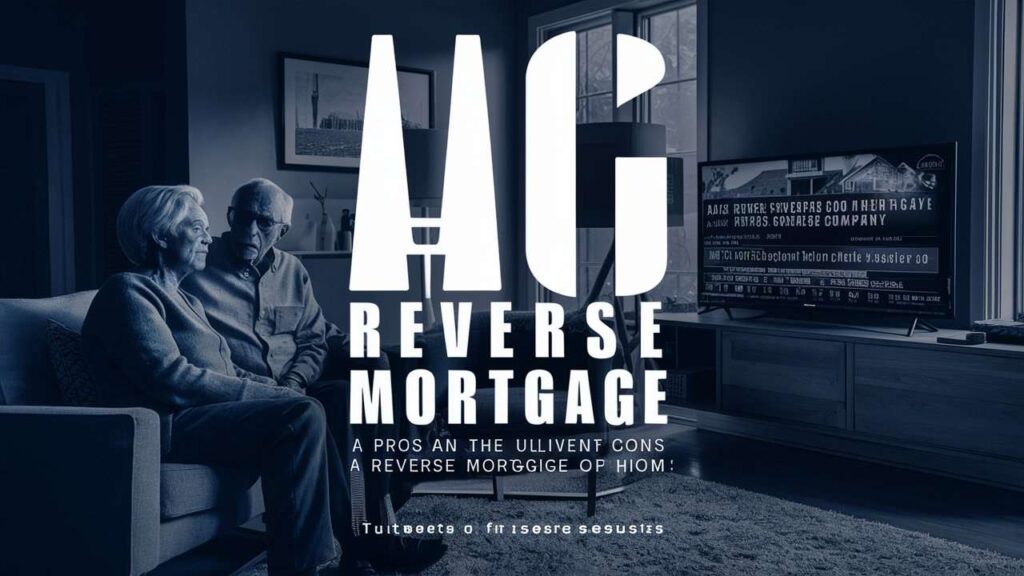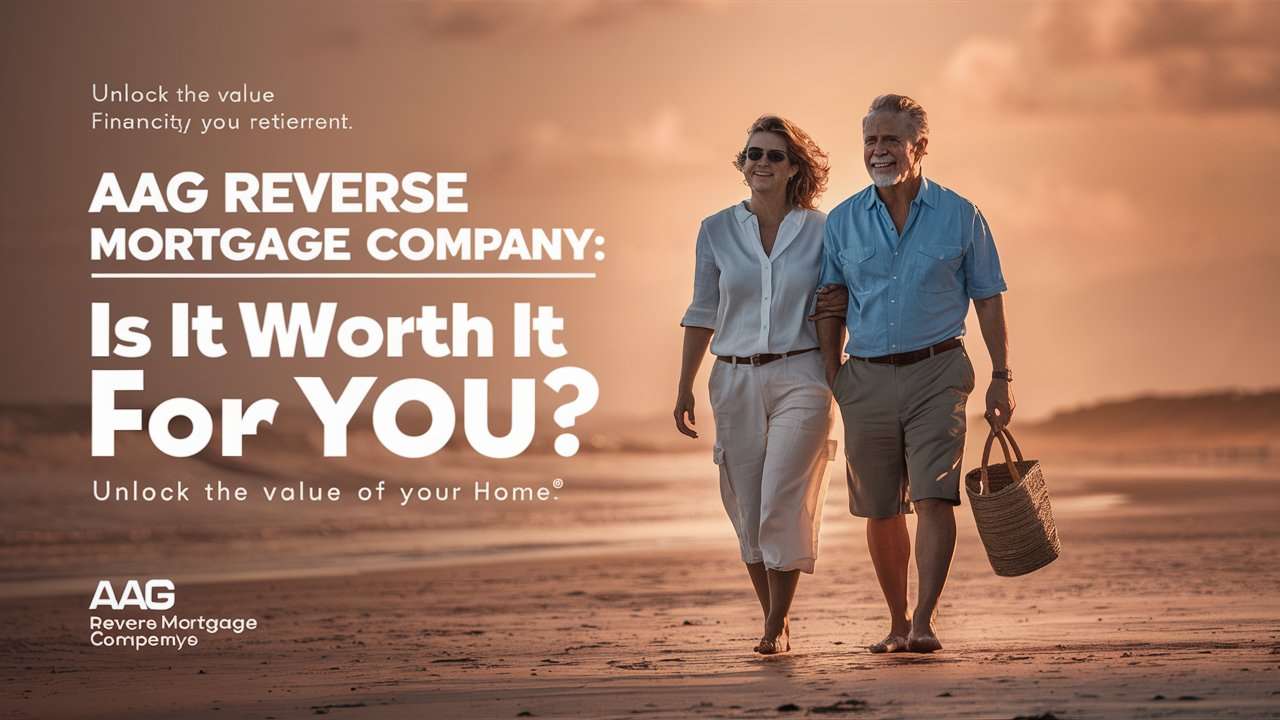When it comes to funding retirement, many homeowners find themselves asset-rich but cash-poor. Enter the reverse mortgage, a financial option that allows you to tap into your home’s equity without having to sell it. But is the AAG Reverse Mortgage the right choice for you? Let’s dive in and figure it out.

What is a Reverse Mortgage, Anyway?
At its core, a reverse mortgage lets you borrow against the value of your home while still living in it. The catch? Instead of making monthly payments, the loan balance increases over time, and is only repaid when you sell the home, move out, or pass away. It’s like the reverse of a traditional mortgage, hence the name. In other words, it’s your home paying you back for all those years of loyalty.
A Brief History of Reverse Mortgages: From Obscurity to Fame
Reverse mortgages didn’t just pop out of nowhere. They’ve been around since the 1960s, originally seen as a last-ditch effort for retirees in need. However, over time, thanks to regulatory tweaks and improved public perception, they’ve grown in popularity. Now, big players like AAG have polished the concept, making reverse mortgages more accessible and (dare we say) respectable.

Meet AAG: Who Are They and Why Should You Care?
AAG, or American Advisors Group, is the largest reverse mortgage provider in the United States. They’ve built a reputation on offering a clear, straightforward process, with a focus on helping seniors unlock the equity in their homes. With endorsements from famous faces and an impressive market share, AAG positions itself as the go-to for reverse mortgages. But are they really all they’re cracked up to be?
How Does a Reverse Mortgage Work? (In Plain English, Please)
Imagine this: You’ve paid off a chunk of your home’s value over the years, and now you can get some of that money back, tax-free. You stay in your home and don’t have to pay the loan back until you move out or sell the house. The loan grows over time as interest and fees accumulate, and when it’s time to settle up, the proceeds from selling the home cover the loan. The kicker? If the home sells for less than what’s owed, you’re not on the hook for the difference💸it’s a non-recourse loan.

The AAG Reverse Mortgage Process: Step by Step Breakdown
- Consultation – Start by chatting with an AAG representative who’ll explain the ins and outs.
- Eligibility Check – They’ll confirm if you qualify based on age, home equity, and other factors.
- Appraisal – Your home gets appraised to determine its current market value.
- Application – You submit the necessary paperwork to formally apply.
- Approval – Once approved, you get access to your funds in a lump sum, monthly payments, or a line of credit.
- Repayment – You repay the loan when you sell the house, move out, or upon death.
Simple, right? Well, mostly.
Eligibility Check: Do You Even Qualify for an AAG Reverse Mortgage?
Eligibility requirements are fairly straightforward. You must be at least 62 years old, own your home outright or have a significant amount of equity, and your property must meet FHA standards. Plus, you’ll need to be able to cover property taxes, homeowners insurance, and maintenance. It’s not just about equity; it’s about making sure you can maintain the home in tip-top shape while you’re still living there.

Home Equity: What It Is and Why It Matters for Your Reverse Mortgage
Home equity is the value of your home minus any mortgage or liens. It’s your stake in the property. For reverse mortgages, the more equity you have, the more cash you can access. AAG and other lenders rely on this equity to determine how much they’re willing to loan you. Simply put: more equity equals more moolah.
The Different Types of Reverse Mortgages AAG Offers
AAG offers several types of reverse mortgages, including:
- Lump sum – You get all your cash upfront.
- Monthly payments – Think of it as a regular income stream.
- Line of credit – Tap into funds when you need them, similar to a credit card.
Each option has its benefits and drawbacks, depending on your financial situation and goals.
AAG Reverse Mortgage Fees: What Are You Really Paying For?
Like any loan, reverse mortgages come with fees. Expect to pay origination fees, closing costs, servicing fees, and interest. The good news? These fees are typically rolled into the loan balance, so you’re not paying anything out of pocket upfront. However, this also means your loan balance will grow faster over time.

Pros of AAG Reverse Mortgage: More Than Just Cash
- Stay in your home – No need to pack up and move.
- Tax-free funds – The money you receive isn’t considered income, so it’s tax-free.
- Flexible payout options – Choose between lump sum, monthly payments, or a line of credit.
- No monthly payments – You’re not required to make monthly payments on the loan.
The Cons: What’s the Catch with AAG Reverse Mortgage?
- Loan balance grows – Since you’re not making payments, the loan balance increases over time.
- Fees can be high – Interest and fees add up, which means less equity left for your heirs.
- It’s not for everyone – If you’re planning to move or leave your home to family, this may not be the best option.
How Much Money Can You Get with an AAG Reverse Mortgage?
The amount you can borrow depends on several factors: your age, the value of your home, and current interest rates. Typically, the older you are and the more valuable your home, the more you can borrow. AAG uses these criteria to calculate your loan amount.
Interest Rates Explained: The Good, the Bad, and the Confusing
Interest rates on reverse mortgages can be either fixed or adjustable. Fixed rates provide stability but might limit how much you can borrow. Adjustable rates give you more flexibility in accessing funds but come with the risk of rising costs over time.

AAG’s Reverse Mortgage vs. Competitors: Who Does It Better?
AAG’s biggest selling point is its customer service and transparency, but competitors like Reverse Mortgage Funding and Longbridge Financial also offer strong products. Each company has its own perks💸whether it’s lower fees, more flexible terms, or a streamlined process💸so it’s worth comparing your options.
What Happens to Your Home After You’re Gone? (Spoiler: It’s Complicated)
Once you pass away, the loan becomes due. Your heirs can either pay off the loan to keep the house or sell the property to repay the loan. If the house sells for less than the loan balance, AAG absorbs the loss. If it sells for more, your heirs get to keep the leftover proceeds.
The Impact on Your Heirs: Do They Get the Short End of the Stick?
If you’re concerned about leaving an inheritance, a reverse mortgage may not be the best choice. While your heirs won’t be responsible for any debt beyond the home’s value, they could end up with little to no equity in the house once the loan is repaid.
AAG Reverse Mortgage and Taxes: What Uncle Sam Has to Say
The good news is that reverse mortgage proceeds aren’t considered taxable income. However, interest on the loan isn’t tax-deductible until it’s paid, meaning you don’t get any tax breaks during the life of the loan.
Is an AAG Reverse Mortgage Safe? Avoiding Scams and Pitfalls
AAG is a reputable company, but the reverse mortgage industry has had its share of bad actors. To stay safe, work with a trusted lender, make sure you fully understand the terms, and consult with a financial advisor before proceeding.

Who Benefits Most from an AAG Reverse Mortgage? (Is That You?)
AAG Reverse Mortgages are ideal for homeowners who want to stay in their homes and need extra cash for retirement. If you have significant equity and don’t plan to leave your home to heirs, this could be a solid option.
Common Misconceptions About AAG Reverse Mortgages Debunked
- Myth: You’re selling your home to the bank.
- Fact: You retain ownership of your home.
- Myth: You’ll owe more than your home is worth.
- Fact: Reverse mortgages are non-recourse loans, meaning you’re not responsible for any shortfall if the loan balance exceeds the home’s value.
What’s It Like to Work with AAG? Customer Reviews and Testimonials
AAG generally receives positive reviews for its customer service, but like any company, it’s not without its critics. Common praises include their informative process and transparency, while some complaints focus on the complexity of fees.
Is It Worth It? Weighing the Pros and Cons for Your Situation
A reverse mortgage can be a great tool for the right person. If you need cash and want to stay in your home, it’s worth considering. But if you’re planning to move or want to leave your home to heirs, it might not be the best choice.
Alternatives to AAG Reverse Mortgages: Is There a Better Option?
If a reverse mortgage doesn’t seem like the best fit, consider alternatives like downsizing, home equity loans, or refinancing. These options may provide the cash you need without the complexities of a reverse mortgage.
How to Decide if AAG Reverse Mortgage Is Right for You
The decision boils down to your financial goals, home equity, and retirement plans. Weigh the pros and cons, consult with experts, and explore your options before making a move
.
Final Verdict: Is AAG Reverse Mortgage Your Retirement Lifeline?
An AAG Reverse Mortgage could be your key to a more comfortable retirement, but it’s not for everyone. If staying in your home and accessing its equity makes sense for your future, AAG might just be your golden ticket. Just make sure you know all the facts before jumping in!
People Also Ask
What is the 60% rule in reverse mortgage?
The 60% rule in reverse mortgages refers to the cap on how much you can borrow in the first year of the loan. Typically, borrowers can access only 60% of their total loan amount in the first 12 months to ensure they don’t deplete their equity too quickly.
Can AAG be trusted?
AAG is a well-established reverse mortgage company and the largest in the U.S. It has a good reputation in the industry for transparency and customer service. However, like any financial product, it’s important to do your research and understand the terms before proceeding.
What does AAG stand for in reverse mortgage?
AAG stands for American Advisors Group, the largest reverse mortgage lender in the United States. They specialize in helping seniors access home equity through reverse mortgages.
What is the AAG controversy?
The AAG controversy primarily revolves around complaints from some customers who felt misled about the terms and costs associated with their reverse mortgages. While the company has a solid reputation overall, it’s important to understand the terms fully before signing.
What is the 95% rule on a reverse mortgage?
The 95% rule applies when the borrower passes away or sells the home. Heirs or the borrower’s estate are only responsible for repaying 95% of the home’s appraised value, even if the loan balance is higher.
How much can a reverse mortgage pay?
The amount a reverse mortgage can pay depends on several factors: the borrower’s age, the home’s value, current interest rates, and how much equity they have. Typically, older borrowers with more valuable homes and higher equity can receive more.
How long can you reverse mortgage?
A reverse mortgage lasts as long as you live in the home as your primary residence. The loan becomes due when you move, sell the home, or pass away.
What percentage can you reverse mortgage?
The percentage you can borrow typically ranges between 40% and 60% of your home’s appraised value, depending on your age, the home’s value, and current interest rates.
What is the maximum loan to value on a reverse mortgage?
The maximum loan-to-value (LTV) ratio for a reverse mortgage is generally around 60%, depending on factors like the borrower’s age, the home’s value, and interest rates.
What is the interest rate on reverse mortgages?
Interest rates for reverse mortgages can vary, but they typically fall between 3% and 6%. Rates can be either fixed or adjustable, depending on the type of reverse mortgage chosen.
How high can a reverse mortgage go?
The maximum reverse mortgage loan amount is determined by the value of your home and your equity. In 2024, the FHA-insured Home Equity Conversion Mortgage (HECM) program has a loan limit of $1,089,300.
What is the lowest age for reverse mortgage?
The lowest age for a reverse mortgage is 62. Only homeowners aged 62 and older are eligible to apply for this type of loan.
What is the maximum term for a reverse mortgage?
There is no set maximum term for a reverse mortgage. It lasts as long as the borrower lives in the home and maintains it as their primary residence.
How much equity is needed for a reverse mortgage?
Generally, you’ll need at least 50% equity in your home to qualify for a reverse mortgage. The more equity you have, the more you can potentially borrow.
Does AAG have a good reputation?
AAG has a solid reputation in the reverse mortgage industry, backed by years of experience and high customer satisfaction ratings. However, as with any financial decision, it’s critical to read reviews and do thorough research.
What is the best reverse mortgage company?
The best reverse mortgage company varies depending on your needs. AAG is highly rated, but other top companies include Reverse Mortgage Funding (RMF) and Longbridge Financial, each offering unique features and customer service.









